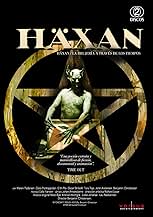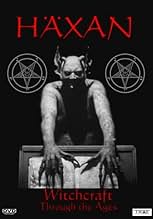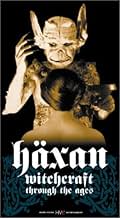Fictionalized documentary showing the evolution of witchcraft, from its pagan roots to its confusion with hysteria in Eastern Europe.Fictionalized documentary showing the evolution of witchcraft, from its pagan roots to its confusion with hysteria in Eastern Europe.Fictionalized documentary showing the evolution of witchcraft, from its pagan roots to its confusion with hysteria in Eastern Europe.
Elisabeth Christensen
- En ældre bondekone
- (as Elizabeth Christensen)
- …
John Andersen
- Chief Inquisitor
- (as Johs Andersen)
Emmy Schønfeld
- Marie, the Seamstress
- (as Emmy Schönfeld)
- Director
- Writer
- All cast & crew
- Production, box office & more at IMDbPro
Storyline
Did you know
- TriviaThe Swedish film censors required numerous cuts in the film, before authorizing its release. Among the censored scenes were the closeup of the finger being removed from the hanged man's hand, the trampling of the cross in the witch's sabbath scene, the shot of the oozing infant held over a cooking pot, a closeup of a woman's face while she is on a torture rack, closeups of several instruments of torture being employed, and a shot of a demon embracing a nude woman (all these shots have since been restored to the film).
- GoofsThe skeletal horse-like creature wandering around during the Sabbath clearly is being moved about by a couple of stage hands, hidden under the blanket that covers its "body". The feet of the crew member at the front of the monster are visible in one shot.
- Quotes
Title Card: Poor little hysterical witch! In the middle ages you were in conflict with the church. Now it is with the law.
- Crazy creditsDirector Benjamin Christensen personally thanks his cinematographer and art director through the opening titles.
- Alternate versionsWitchcraft Through the Ages (1968), the 76-minute version of Häxan, narrated by William S. Burroughs, with a soundtrack featuring Jean-Luc Ponty
- ConnectionsEdited into From Camille to Joan of Arc (1961)
Featured review
And I couldn't be more pleased! I have never seen this film, but thought I would try it out, as I have always had a fascination with the grotesque, mysticism, and the occult. Haxan delivers in spades.
This 1922 Danish silent film about black magic, witches, satanism, and the persecution of said subjects during the middle-ages, which attempts to make a connection between the ancient phenomena and the modern study of hysteria (modern in 1922), has been wonderfully presented by The Criterion Collection in their new dvd. This new Criterion dvd has the original 104 min. version with a newly recorded 5.0 soundtrack orchestrated from archival documentation, and the 76 min. version released in 1967, which has narration by legendary counter-culture icon William S. Burroughs.
Watching the original version, I found it full of great imagery and fine silent acting. Emotions and actions are superbly conveyed by the actors, and the sets, costumes, lighting, and effects are all wonderfully done. I especially like the interrogation chamber and the Sabbath scenes, which display lots of good props and much deviltry with rather convincing special effects and make-up. The movie is structured in seven chapters, the first giving a historical account of witchcraft's origins in literature and illustrations. We then are presented with drama plays, having to do with the practice of witches, and the persecution, trying, and torturing of said witches. We are also presented with several instances of the devil manifesting and making demands on his minions. In the end, Christensen attempts to make a correlation between the acts, mannerisms, and various disfigurements anciently attributed to witches and their craft, and the modern affects of hysteria. This is apparently the most criticized part of the film, as mentioned in the commentary, and while it certainly is not as strong as the period dramas, I think it does a good job of raising valid questions, and does work with the film quite well.
As for the quality of the transfer... with the exception of element specs throughout, and just a few scenes marred by scrapes, the print is very clean and clear. I thought it looked great. True, the print could have been cleaned up a bit more as far as the specs go, but not every film Criterion does will get the star treatment given Akira Kuroswa's "Seven Samurai". So long as contrast is good, and edges are well defined, I'm usually a happy camper, and this transfer delivers.
The new score was arranged by film music specialist Gillian Anderson who attempted to recreate the music presented at the film's Danish premiere as best as possible by referencing the list of musical cues printed in the theater's weekly program notes. It includes works from Franz Schubert, Richard Wagner, Max Bruch, W.A. Mozart, Tchaikovsky, Christoph Gluck, and Ludwig Van Beethovan, as well as others. Anderson conducted the Czech Film Orchestra in June 2001. The score does an incredible job of accompanying the film, sounds wonderful, and is is presented in 5.0 Dolby Digital.
There is a knock-out commentary here. Narrated by Danish silent film scholar Caspar Tybjerg, the commentary centers on the director Benjamin Christensen's life in film, the Danish silent film industry, origin of the documentary film genre, technical aspects of Haxan, the cast of Haxan, historical aspects of the study of hysteria in psychology circles, the origins of the devil as a character in media, and of course, the phenomena of witchcraft and witch hunting. References are made to Nosferatu, Cabinet of Dr. Caligari, the German Expressionist movement, The Passion of Joan of Arc, The Seventh Seal, Sigmund Freud... the list goes on and on. While there is an incredible amount of information presented here, with bibliographic references even, Tybjerg does an excellent job of tying it all together and presenting the relevance of the material to the film. This was a very engaging look at Christensen, his film, and the sociological atmosphere both during the middle-ages, and during the time of Haxan's production.
As for the 1967 version narrated by William S. Burroughs, "Witchcraft Through The Ages"... I must say that I have not sat through the whole thing. In fact, I just watched the first two segments before finally succumbing to sleep (I have, gladly, spent a LOT of time with this dvd, but have to sleep sometime). My first impression is, while Burroughs is always so interestingly droning yet intense in the same breath, the jazz score was just plain ridiculous, in the presentation of Haxan anyway. The producer composed a jazz score for the film, which by itself, is some very hip music indeed, but it was just terribly out of place in the film. I'm sure the production was aiming to enhance drug trips rather than present the film itself. With Burroughs involvement, I don't think I'm too far of base in this. I'll have to give it another go when I've had some sleep, so I can watch the whole thing, but I doubt I'll be changing my mind. The jazz score is just too out of place, and as Christensen has often said, dialogue would ruin Haxan, as well as several silent films. After witnessing this 1967 version, I must agree with the director.
For avid students of special effects, I would make an evening of it with Haxan, as well as Jean Cocteau's "Beauty and the Beast", and "Der Golum", found on Elite's "Masterworks of the German Horror Cinema" dvd set. Much mysticism, magic and enchantment abound in these films, and state-of-the-art at-the-time special effects to boot.
I am extremely happy with this dvd, and highly recommend it to anyone who is into the study of classic film or anyone who is interested in the occult, whether solely for entertainment or as a study of sociological phenomena.
This 1922 Danish silent film about black magic, witches, satanism, and the persecution of said subjects during the middle-ages, which attempts to make a connection between the ancient phenomena and the modern study of hysteria (modern in 1922), has been wonderfully presented by The Criterion Collection in their new dvd. This new Criterion dvd has the original 104 min. version with a newly recorded 5.0 soundtrack orchestrated from archival documentation, and the 76 min. version released in 1967, which has narration by legendary counter-culture icon William S. Burroughs.
Watching the original version, I found it full of great imagery and fine silent acting. Emotions and actions are superbly conveyed by the actors, and the sets, costumes, lighting, and effects are all wonderfully done. I especially like the interrogation chamber and the Sabbath scenes, which display lots of good props and much deviltry with rather convincing special effects and make-up. The movie is structured in seven chapters, the first giving a historical account of witchcraft's origins in literature and illustrations. We then are presented with drama plays, having to do with the practice of witches, and the persecution, trying, and torturing of said witches. We are also presented with several instances of the devil manifesting and making demands on his minions. In the end, Christensen attempts to make a correlation between the acts, mannerisms, and various disfigurements anciently attributed to witches and their craft, and the modern affects of hysteria. This is apparently the most criticized part of the film, as mentioned in the commentary, and while it certainly is not as strong as the period dramas, I think it does a good job of raising valid questions, and does work with the film quite well.
As for the quality of the transfer... with the exception of element specs throughout, and just a few scenes marred by scrapes, the print is very clean and clear. I thought it looked great. True, the print could have been cleaned up a bit more as far as the specs go, but not every film Criterion does will get the star treatment given Akira Kuroswa's "Seven Samurai". So long as contrast is good, and edges are well defined, I'm usually a happy camper, and this transfer delivers.
The new score was arranged by film music specialist Gillian Anderson who attempted to recreate the music presented at the film's Danish premiere as best as possible by referencing the list of musical cues printed in the theater's weekly program notes. It includes works from Franz Schubert, Richard Wagner, Max Bruch, W.A. Mozart, Tchaikovsky, Christoph Gluck, and Ludwig Van Beethovan, as well as others. Anderson conducted the Czech Film Orchestra in June 2001. The score does an incredible job of accompanying the film, sounds wonderful, and is is presented in 5.0 Dolby Digital.
There is a knock-out commentary here. Narrated by Danish silent film scholar Caspar Tybjerg, the commentary centers on the director Benjamin Christensen's life in film, the Danish silent film industry, origin of the documentary film genre, technical aspects of Haxan, the cast of Haxan, historical aspects of the study of hysteria in psychology circles, the origins of the devil as a character in media, and of course, the phenomena of witchcraft and witch hunting. References are made to Nosferatu, Cabinet of Dr. Caligari, the German Expressionist movement, The Passion of Joan of Arc, The Seventh Seal, Sigmund Freud... the list goes on and on. While there is an incredible amount of information presented here, with bibliographic references even, Tybjerg does an excellent job of tying it all together and presenting the relevance of the material to the film. This was a very engaging look at Christensen, his film, and the sociological atmosphere both during the middle-ages, and during the time of Haxan's production.
As for the 1967 version narrated by William S. Burroughs, "Witchcraft Through The Ages"... I must say that I have not sat through the whole thing. In fact, I just watched the first two segments before finally succumbing to sleep (I have, gladly, spent a LOT of time with this dvd, but have to sleep sometime). My first impression is, while Burroughs is always so interestingly droning yet intense in the same breath, the jazz score was just plain ridiculous, in the presentation of Haxan anyway. The producer composed a jazz score for the film, which by itself, is some very hip music indeed, but it was just terribly out of place in the film. I'm sure the production was aiming to enhance drug trips rather than present the film itself. With Burroughs involvement, I don't think I'm too far of base in this. I'll have to give it another go when I've had some sleep, so I can watch the whole thing, but I doubt I'll be changing my mind. The jazz score is just too out of place, and as Christensen has often said, dialogue would ruin Haxan, as well as several silent films. After witnessing this 1967 version, I must agree with the director.
For avid students of special effects, I would make an evening of it with Haxan, as well as Jean Cocteau's "Beauty and the Beast", and "Der Golum", found on Elite's "Masterworks of the German Horror Cinema" dvd set. Much mysticism, magic and enchantment abound in these films, and state-of-the-art at-the-time special effects to boot.
I am extremely happy with this dvd, and highly recommend it to anyone who is into the study of classic film or anyone who is interested in the occult, whether solely for entertainment or as a study of sociological phenomena.
- mutleyhyde
- Oct 19, 2001
- Permalink
Details
- Release date
- Countries of origin
- Languages
- Also known as
- Häxan: Witchcraft Through the Ages
- Filming locations
- Production companies
- See more company credits at IMDbPro
Box office
- Budget
- SEK 2,000,000 (estimated)
Contribute to this page
Suggest an edit or add missing content


![Watch Trailer [OV]](https://m.media-amazon.com/images/M/MV5BNWUzNDFkOTAtYTdiZi00M2RiLWJiMjktZmZjM2RkNzNhMzBiXkEyXkFqcGdeQXRyYW5zY29kZS13b3JrZmxvdw@@._V1_QL75_UX500_CR0)




























